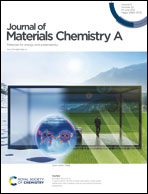Tuning CO binding strength via engineering the copper/borophene interface for highly efficient conversion of CO into ethanol†
Abstract
Currently, copper is the most active monometallic catalyst to generate hydrocarbon and oxygenated products. Nevertheless, the huge kinetic barrier of Cu surfaces for the formation of a C–C bond on the path toward C2+ products has remained unsolved to date. In this work, inspired by the successful growth of 2D borophene on Cu (111) surfaces [Nat. Nanotechnol., 2019, 14 (1), 44], we introduce a high density of one-dimensional copper/borophene interface sites for the C–C coupling reaction by using a framework of density functional theory calculations. Cu alone interacts very weakly with CO, while its synergistic interfacial interactions with boron atoms could significantly boost the CO binding strength, thus facilitating C–C coupling. The Cu–boron interface delivers an ultra-low kinetic energy barrier of only 0.42 eV for the CO dimerization step and a thermodynamic potential limiting step of only 0.61 V for the hydrogenation process toward ethanol production, inhibiting the hydrogen evolution reaction. The improved intrinsic catalytic activity can be ascribed to both the synergistic electronic and structural interactions between metal Cu and non-metal B atoms at the interface. Our work predicts an unprecedented family of low-dimensional nanohybrid catalysts towards the efficient electroreduction of CO to ethanol, thus providing a new class of guiding design principles for the broad experimentalist community.



 Please wait while we load your content...
Please wait while we load your content...